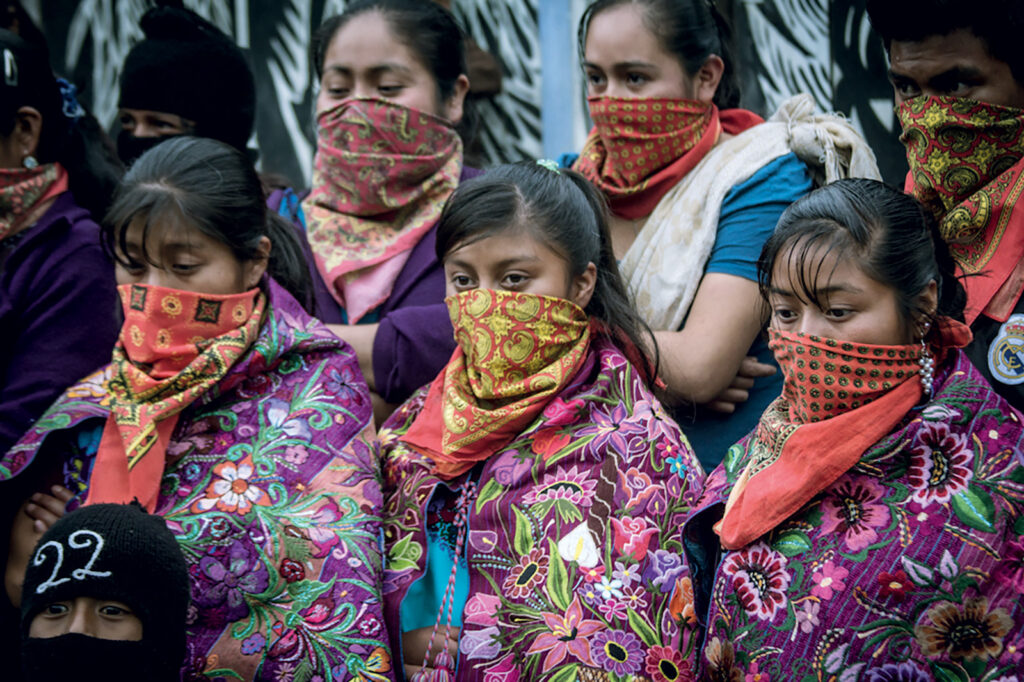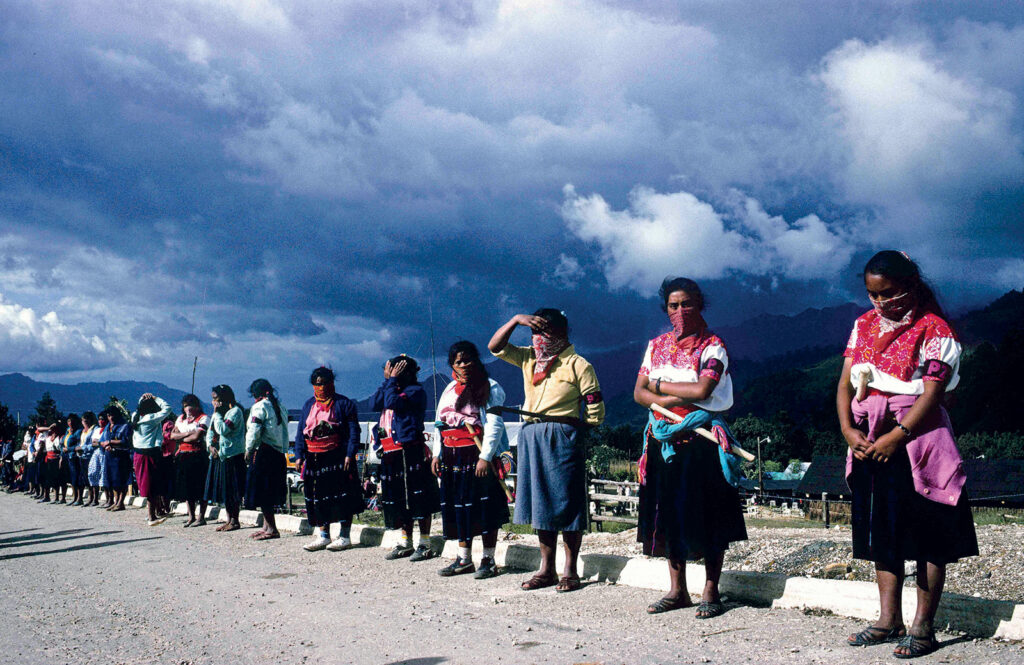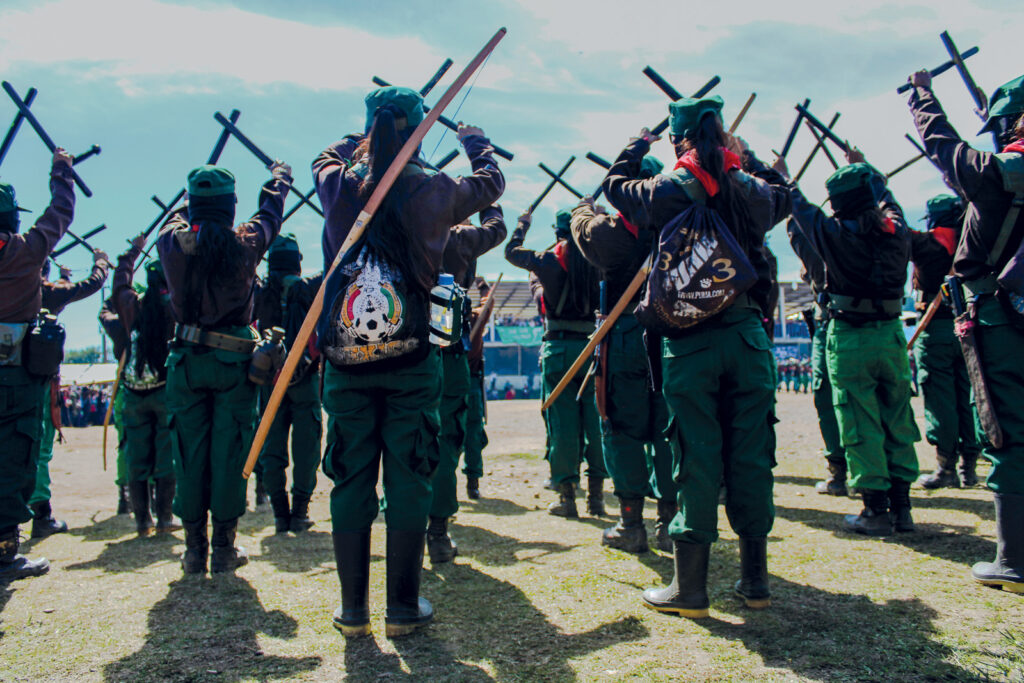
The Women’s Revolutionary Law: A new justice for indigenous women
Photo by Heriberto Paredes.
R. Aída Hernández Castillo
The Women’s Revolutionary Law, enacted by the Zapatista Army of National Liberation (EZLN) thirty years ago has become a symbol of struggle for a dignified life. Over three decades, indigenous women throughout the continent have echoed the zapatista demands, reclaiming the collective and territorial rights that belong to them as members of their communities, but also their specific rights as women before community authorities and the patriarchal State. The Women’s Revolutionary Law was a watershed for the feminisms that were challenged by their anti-racist, anti-capitalist and anti-patriarchal demands. As a result we have seen in the Americas the emergence of feminisms that, labeling themselves in different ways, —decolonial, community-based, territorial, etc. —have placed in the center a defense of the casa común (common home) from a perspective that confronts the perspectives of liberal law.

A revolutionary law by and for women
The inclusion of women in the “official” Zapatista discourse contributed to legitimize their demands within the national agenda of the movement. In addition, the numerical and political importance of indigenous women within the EZLN drew attention since their public appearance in 1994. Several were at the forefront of the takeover of municipal presidencies, and some -such as the comandantas Ramona, Trini and Andrea and lieutenant Ana María- soon became symbols of resistance. Their participation in guerrilla leadership contrasts with other revolutionary experiences in Latin America, but the main difference is that their gender demands were incorporated through the Revolutionary Women’s Law. Much has been written in academia, journalism and activism about the content and impact of this law, although Subcomandante Marcos was the first to describe in detail the origin of the document in the framework of the first Zapatista uprising:
Susana, a Tsotsil, is angry. A while ago they made fun of her because, the others in the CCRI 1say, she was to blame for the first EZLN uprising, in March 1993. “I’m angry,” she tells me. […] “The compañeros say that it was my fault that the Zapatistas rose up last year.” I start to approach, cautious. Then I find out what it’s about: in March 1993, the compañeros were discussing what would later become the Revolutionary Laws. Susana had to travel through dozens of communities to talk to the women’s groups and thus draw from their thoughts the Women’s Law.2
The aforementioned law consists of ten points, among which are the right of indigenous women to political participation and to occupy leadership positions, to a life free of sexual and domestic violence, to choose whom to marry, to decide how many children to have and care for, to a fair salary and to good health and education services, among others. Although this law is not known in detail by all indigenous women in Mexico, it has helped to create what Karl-Werner Brand calls a “cultural climate” that makes it possible to denaturalize inequality because it “generates a specific sensitivity to some or other problems, narrows or widens the horizon of what seems socially and politically viable, determines the patterns of political behavior and lifestyle, and channels psychosocial energies outward, to the public sphere, or inward, to the private sphere.”
As a result of this cultural climate, many indigenous organizations in Mexico began to integrate the issue of inequalities between men and women into their spaces for collective reflection: the argument that it was not possible to fight for justice for indigenous peoples, while women were treated unfairly on a daily basis, began to be raised in their regional and national meetings. Furthermore, the influence of Zapatismo and this law was reflected in the construction of a movement of indigenous women in various regions of the country, who began to raise their voices not only to support the demands of their compañeros or represent the interests of their communities, but also to demand respect for their specific rights as women. While fighting for land and democracy, they began to demand more democratic relations within the family, the community and the organizations.
The emergence of this new movement is the result of a long process of organization and reflection between Zapatistas and non-Zapatistas who have also been involved. In this sense, the migratory phenomenon, religious groups, feminist non-governmental organizations and even official development programs have influenced the way in which indigenous men and women have restructured their relationships within the domestic unit and redefined their strategies of struggle. Although there is not yet a unified national indigenous women’s movement, much less a national indigenous feminism, the Zapatistas, in concert with members of indigenous women’s organizations across the country, compel us to recognize that struggles against racism, sexism and economic exploitation can and should be complementary and simultaneous.
Indigenous women in the face of cultural recognition policies
In several regions of Latin America, indigenous women are adopting global discourses on women’s rights, while defending the right of their peoples to maintain their own spaces of community justice and, in a broader sense, their political and territorial autonomy. There has long been a new context that recognizes the “multicultural character of the nation” that has led indigenous peoples to reflect, theorize and systematize their cultural practices. In debating and rethinking how culture and tradition are understood, the genders are negotiating these and other definitions.
In this regard, many liberal feminists argue that the recognition of indigenous rights represents a step backward for women’s rights. In Mexico, the feminist position and that of the indigenous movement have become polarized; the differences deepened in the last three decades after the Zapatista movement proposed the need for a constitutional reform that would recognize the autonomous rights of indigenous peoples. An important sector of liberal feminism in the country then made alliances with liberal anti-autonomy groups to warn of the dangers for indigenous women if the collective rights of their peoples were recognized.
The processes of “political creativity” I have mentioned confront these feminist critiques, as indigenous women have demonstrated that they are working within their communities to achieve a cultural transformation of gender. Moreover, at this political crossroads, the organized indigenous women themselves have given us clues to rethink the demands of their peoples from a non-essentialist perspective: their theorizations on culture, tradition and gender equity are found in Zapatista documents, in the memories of their gatherings and in their public discourse. Moreover, they have never asked for the “protection” of liberal intellectuals or of the State, which basically seeks to limit the autonomy of the peoples. On the contrary, they have claimed the right to self-determination and culture while struggling within the indigenous movement to redefine the terms in which their traditions and customs are understood, so that they can actively participate in the construction of autonomous projects, as well as reconstitute the spaces of their own justice.
Specifically, indigenous women are rethinking the “traditions and customs” in the community regulations governing justice. In different parts of the country, their organizational processes have led them to influence and participate directly in community justice spaces. For example, in the Zapatista autonomous regions in Chiapas, in the communities of the Regional Coordinator of Community Authorities (CRAC) in Guerrero, in the Indigenous Court of Cuetzalan, Puebla, or in the community assemblies of the Mixe or Ayuujk people in Santa María Tlahuitoltepec, they struggle to redraft community regulations and include their rights as women in the formulation of indigenous law. Although these are incipient experiences and, therefore, it is not possible to extend the analysis to all indigenous regions of Mexico, they have a symbolic importance in the new discourses and imaginaries on indigenous law, and are part of what we have called the new transformative constitutionalism.3

The autonomous justice of the communities
The San Andres Accords, signed in 1996, laid the foundations for the creation of de facto autonomous regions, which is to say, they have no legal recognition by the Mexican State, but have been tolerated, ignored or repressed by the different governments of the last decades. The new structures and norms of Zapatista justice were consolidated as an autonomous system in that year. Later, in 2001, the Congress of the Union approved a new constitutional reform, known as the Law of Indigenous Rights and Culture, which included some aspects of the agreements in a very diluted form, but in essence violated what had been agreed between the EZLN and the federal government regarding the rights to territorial autonomy and the management of their natural resources. After an intense struggle, which included marches, forums and national meetings, and in the face of the disenchantment caused by that limited indigenous law -considered a betrayal by the Mexican political class-, the movement continued with its own autonomous project on the margins of the State.
In 2003, Zapatista autonomy was restructured by separating military and civilian authorities and improved coordination between the regions with the creation of five Caracoles, administrative units that integrate the autonomous municipalities and have as their highest authority the Good Government Councils. Thus, the Zapatistas have disputed the power of the State by imparting justice not only for their support bases, but also for the non-Zapatista population that turns to them.
The elders have a very important role as advisors in intra-community conflicts, but the maximum authority continues to be the assembly. The Honor and Justice Commission complements the spaces of justice in this autonomous system. If problems cannot be resolved at the community level, they go to this commission, made up of men and women from the Zapatista grassroots.
This is where women’s participation has changed previous dynamics. Although it is a challenge for many to participate because they are not used to speaking publicly, and despite the fact that community justice spaces are still marked by sex-gender ideologies that exclude them from political decision-making, the Zapatistas of the new generations have taken refuge in the Revolutionary Women’s Law to fight for more participation and for other types of conciliatory processes in which their voices can be heard. In this regard, the work of the Honor and Justice Commission involves the training and education of young women in the knowledge of their rights. Thus, in these thirty years of Zapatismo, women born and educated within the autonomous regions have made the Revolutionary Law their own and are currently seeking to build spaces of justice with “women’s minds and hearts.”
Moreover, taking into account that the ethnocentrism of Mexican feminisms has been questioned, the concept of gender, redefined by the voices and practices of the Zapatistas as a multidimensional category, shows us that the struggles against racism and capitalism are an integral part of the construction of a dignified life for women. The contributions of the Zapatistas and other organized indigenous women are found in the documents of their meetings, in workshops, congresses, presentations and interviews with several of them, and are published in feminist magazines as well as in the national press. From their theorizations they invite us, indirectly, to build a more inclusive feminism, where the struggles against capitalist, racist and colonial violence are an integral part of our anti-patriarchal agendas.
Cover image: Photograph by © Heriberto Paredes
This article was published by Cultura UNAM: Revista de la Universidad de Mexíco in December of 2023. https://www.revistadelauniversidad.mx/articles/69b13786-06db-4c63-be1b-b4979f82bbd1/la-ley-revolucionaria-de-mujeres-una-justicia-nueva-para-las-indigenas
English translation by Schools for Chiapas.
Footnotes
- Comité Clandestino Revolucionario Indígena
- “Letter from Subcomandante Marcos about daily life in the EZLN.” 26th of January 1994. Available in Spanish here.
- I use the concept of “transformative constitutionalism” to refer to the reforms that succeeded in including the demands of indigenous struggles in national Constitutions, breaking with many of their Eurocentric constitutional principles – as in the Ecuadorian and Bolivian cases – but also to allude to indigenous justice systems that have their own Constitutions, the product of political agreements, which created their own institutions and legal and political mechanisms to defend those agreements.
